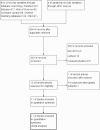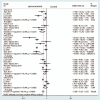Preoperative intravenous glucocorticoids can reduce postoperative acute pain following total knee arthroplasty: A meta-analysis
- PMID: 28858092
- PMCID: PMC5585486
- DOI: 10.1097/MD.0000000000007836
Preoperative intravenous glucocorticoids can reduce postoperative acute pain following total knee arthroplasty: A meta-analysis
Abstract
Background: The ability of preoperative intravenous glucocorticoids to control pain after total knee arthroplasty (TKA) has been examined in many studies, but it remains controversial. Therefore, we undertook a meta-analysis of randomized controlled trials (RCTs) to evaluate the efficacy and safety of preoperative intravenous glucocorticoids for postoperative pain management after TKA.
Methods: We systematically searched RCTs from electronic databases, including PubMed, Embase, Web of Science, the Cochrane Library, the Chinese Wanfang Database, and the China National Knowledge Infrastructure database. The outcomes included visual analogue scale (VAS) scores at 6, 12, 24, 48, and 72 hours after TKA; the occurrence of postoperative nausea and vomiting (PONV); blood glucose at 6 and 24 hours after TKA; and the occurrence of infection.
Results: Of the identified studies, a total of 11 RCTs involving 1000 patients (glucocorticoids = 501, control = 499) were included in this meta-analysis. Compared with a placebo, preoperative intravenous glucocorticoids significantly reduced VAS scores at 6, 12, 24, and 48 hours, with decreases of 3.63 points, 6.81 points, 10.40 points, and 3.15 points, respectively, on a 110-point VAS. Moreover, intravenous glucocorticoids were associated with significant decreases of 19.4% and 16.8% in the occurrence of nausea and vomiting, respectively. However, intravenous glucocorticoids were also associated with increased blood glucose with no clinical importance at 6 hours after TKA. No significant difference was found in the occurrence of infection or in blood glucose at 24 hours after TKA.
Conclusion: Preoperative intravenous glucocorticoids are an effective and safe method to reduce postoperative pain and PONV in patients following TKA. More studies are necessary to identify the optimal dose and type of glucocorticoids for maximal pain control.
Conflict of interest statement
The authors report no conflicts of interest.
Figures












Similar articles
-
Perioperative intravenous glucocorticoids can decrease postoperative nausea and vomiting and pain in total joint arthroplasty: A meta-analysis and trial sequence analysis.Medicine (Baltimore). 2017 Mar;96(13):e6382. doi: 10.1097/MD.0000000000006382. Medicine (Baltimore). 2017. PMID: 28353565 Free PMC article. Review.
-
Local infiltration vs epidural analgesia for postoperative pain control after total knee or hip arthroplasty: A meta-analysis of randomized controlled trials.Medicine (Baltimore). 2020 Oct 30;99(44):e22674. doi: 10.1097/MD.0000000000022674. Medicine (Baltimore). 2020. PMID: 33126306 Free PMC article.
-
Intravenous glucocorticoid for pain control after spinal fusion: A meta-analysis of randomized controlled trials.Medicine (Baltimore). 2018 May;97(20):e10507. doi: 10.1097/MD.0000000000010507. Medicine (Baltimore). 2018. PMID: 29768324 Free PMC article.
-
Can Preoperative Intravenous Corticosteroids Administration Reduce Postoperative Pain Scores Following Spinal Fusion?: A Meta-Analysis.J Invest Surg. 2020 Apr;33(4):307-316. doi: 10.1080/08941939.2018.1505983. Epub 2019 Jan 15. J Invest Surg. 2020. PMID: 30644783
-
Local anesthetic infusion pump for pain management following total knee arthroplasty: a meta-analysis.BMC Musculoskelet Disord. 2017 Jan 23;18(1):32. doi: 10.1186/s12891-016-1382-3. BMC Musculoskelet Disord. 2017. PMID: 28114927 Free PMC article.
Cited by
-
The Ramifications of Opioid Utilization and Outcomes of Alternative Pain Control Strategies for Total Knee Arthroplasties.Orthop Rev (Pavia). 2022 Aug 30;14(3):37496. doi: 10.52965/001c.37496. eCollection 2022. Orthop Rev (Pavia). 2022. PMID: 36045694 Free PMC article.
-
Clinical experience with the use of inhaled isopropyl alcohol to treat nausea and vomiting: A narrative review.Saudi J Anaesth. 2023 Jul-Sep;17(3):383-390. doi: 10.4103/sja.sja_151_23. Epub 2023 Jun 22. Saudi J Anaesth. 2023. PMID: 37601520 Free PMC article. Review.
-
Increased postoperative dexamethasone and gabapentin reduces opioid consumption after total knee arthroplasty.Knee Surg Sports Traumatol Arthrosc. 2019 Jul;27(7):2167-2172. doi: 10.1007/s00167-019-05449-8. Epub 2019 Mar 2. Knee Surg Sports Traumatol Arthrosc. 2019. PMID: 30826856
-
Preoperative intravenous glucocorticoids can decrease acute pain and postoperative nausea and vomiting after total hip arthroplasty: A PRISMA-compliant meta-analysis.Medicine (Baltimore). 2017 Nov;96(47):e8804. doi: 10.1097/MD.0000000000008804. Medicine (Baltimore). 2017. PMID: 29381983 Free PMC article.
-
High-dose glucocorticoid before hip and knee arthroplasty: To use or not to use-that's the question.Acta Orthop. 2018 Oct;89(5):477-479. doi: 10.1080/17453674.2018.1475177. Epub 2018 May 21. Acta Orthop. 2018. PMID: 29781366 Free PMC article. No abstract available.
References
-
- Kurtz S, Ong K, Lau E, et al. Projections of primary and revision hip and knee arthroplasty in the United States from 2005 to 2030. J Bone Joint Surg Am 2007;89:780–5. - PubMed
-
- Terkawi AS, Mavridis D, Sessler DI, et al. Pain management modalities after total knee arthroplasty: a network meta-analysis of 170 randomized controlled trials. Anesthesiology 2017;126:923–37. - PubMed
Publication types
MeSH terms
Substances
LinkOut - more resources
Full Text Sources
Other Literature Sources
Medical

